TRUDI LUDWIG JOHNSON: Her 14-year Odyssey
INTRODUCTION
This saga goes back so far that it would be appropriate to begin: Once upon a time. Trudi Ludwig Johnson, a Maryland Institute College of Art (MICA) academic adviser and adjunct faculty member, has already been the subject of an Art I See blog post in October 2012, when she had begun cutting her second of two large masterful skeletal woodcuts based on Italian Renaissance paintings. (http://www.scottponemone.com/down-to-the-bone/) But the story begins 12 years earlier when Trudi was working on the first woodcut. I had the fortune to meet her at this time and become entranced by her work and artistic ambition. As a result I wrote an article for the fall 2000 issue of the Newsletter of the Print, Drawing & Photograph Society of the Baltimore Museum of Art.
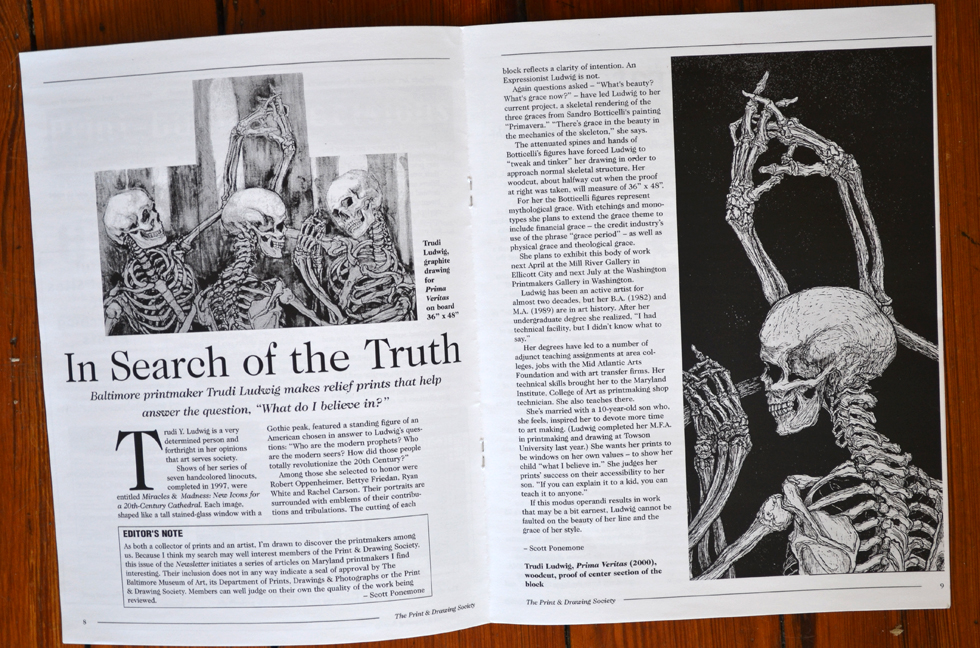
I seriously thought about purchasing her first woodcut, but, if I recall, I had qualms about the drawing of one of the bony necks. Yet once I learned that she planned a second large skeletal woodcut, I heartily encouraged her to do so. Years passed without her working on #2. Whenever I’d see Trudi, I couldn’t help but inquire about it. I suspect I was a pest. She should have berated me for being a noodge, but she never did. Then in the summer of 2012 she invited me to her house to see the early stages of cutting #2. This too led to a Newsletter article.
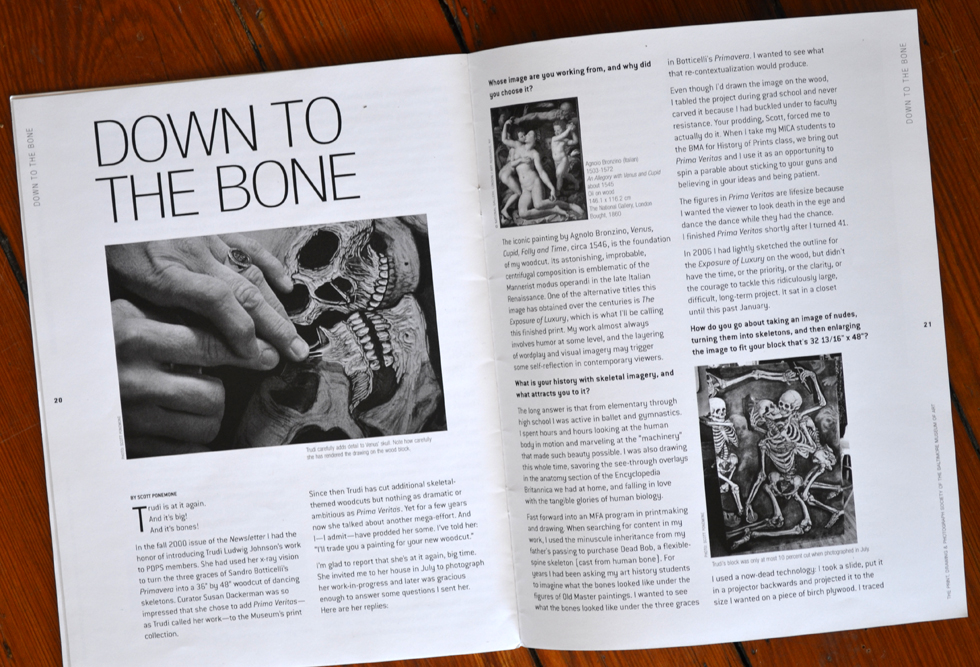
Trudi worked diligently to finish the second woodcut in time for a solo exhibition that winter by the Washington Printmakers Gallery. One wall was devoted to her second woodcut. Even the woodblock was hung beside three impressions. But I have to admit to being a bit disappointed. Irregularities in the plywood block left a vertical less-well-inked stripe down the middle. I realized Trudi’s work was not over.
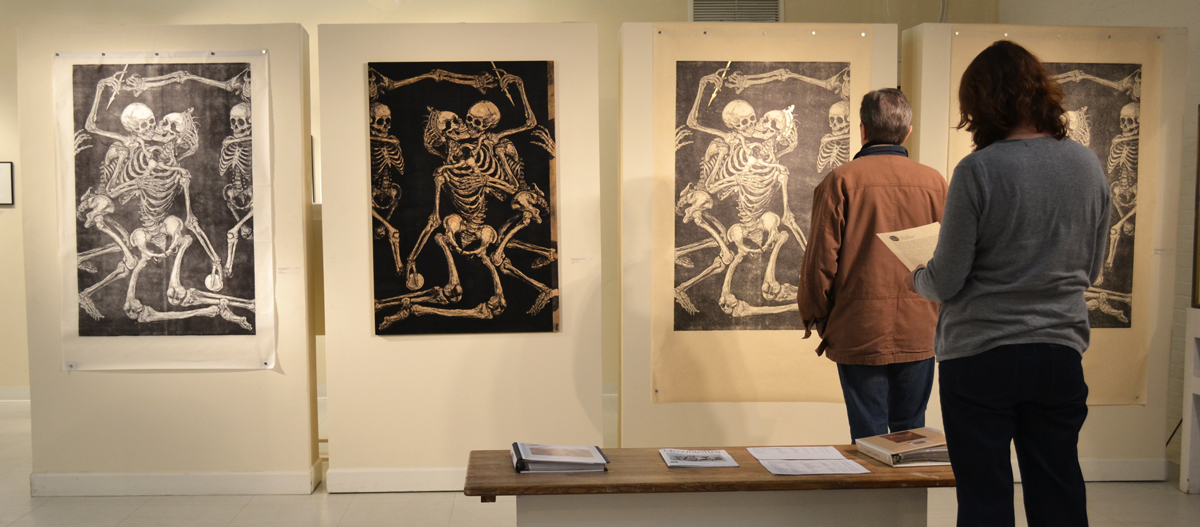
At Trudi’s Washington Printmakers exhibition the woodblock (second from the left) was hung as well. The unevenness of the inking is most evident on the left-most print. (Photo by Scott Ponemone)
Not until the fall of 2014 did Trudi solve her inking issues and complete both editions. In December 2014 she brought over both editions and let me pick one of each in trade for one of my watercolors from my Up In Arms series. Not surprisingly–this woman of bones–chose a picture of a vulture being held aloft by a gloved handler. At that time we agreed that I would purchase magnetic tape and neodymium magnets so together we could hang them in my house just like how Trudi had hung them in her exhibition. (Note the little discs running atop each print and at the corners of the bottom of each print.) Finally in February 2015 they were hung. Michael Frommeyer, my husband, photographed us doing so, and afterwords I recorded a conversation between Trudi and me about her work.
INTERVIEW
Prima Veritas
The interview began in my office where Prima Veritas, Trudi’s first major woodcut, was hung. This was a most appropriate location because I seem to have a skeletal theme running there.
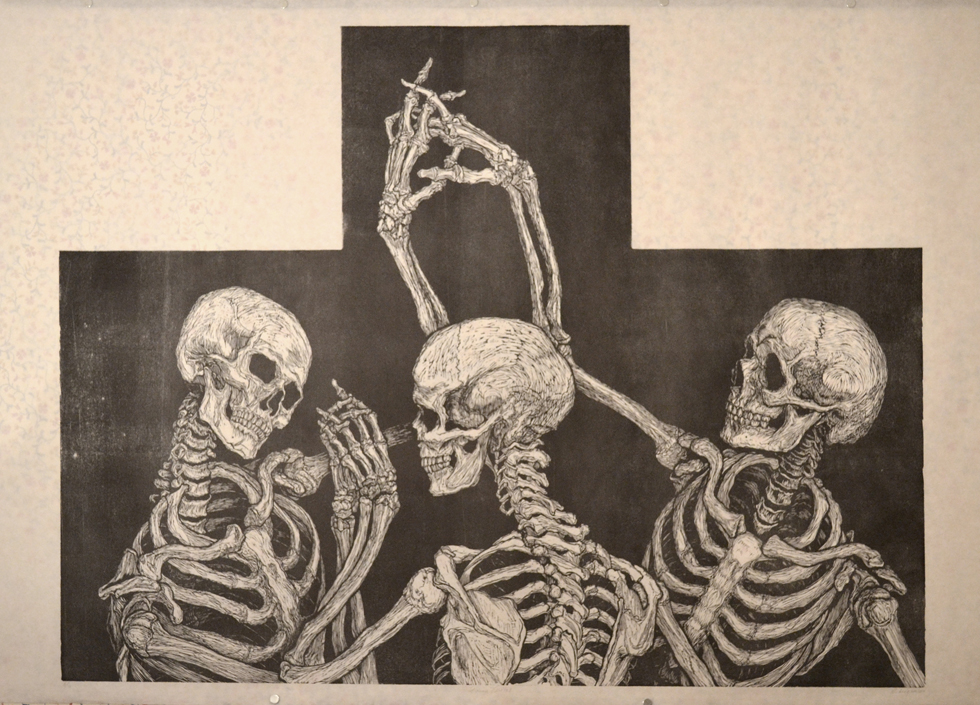
Trudi Ludwig Johnson, Prima Veritas, woodcut, 2000/2014, 6/10, 36″ x 48″, on mulberry paper
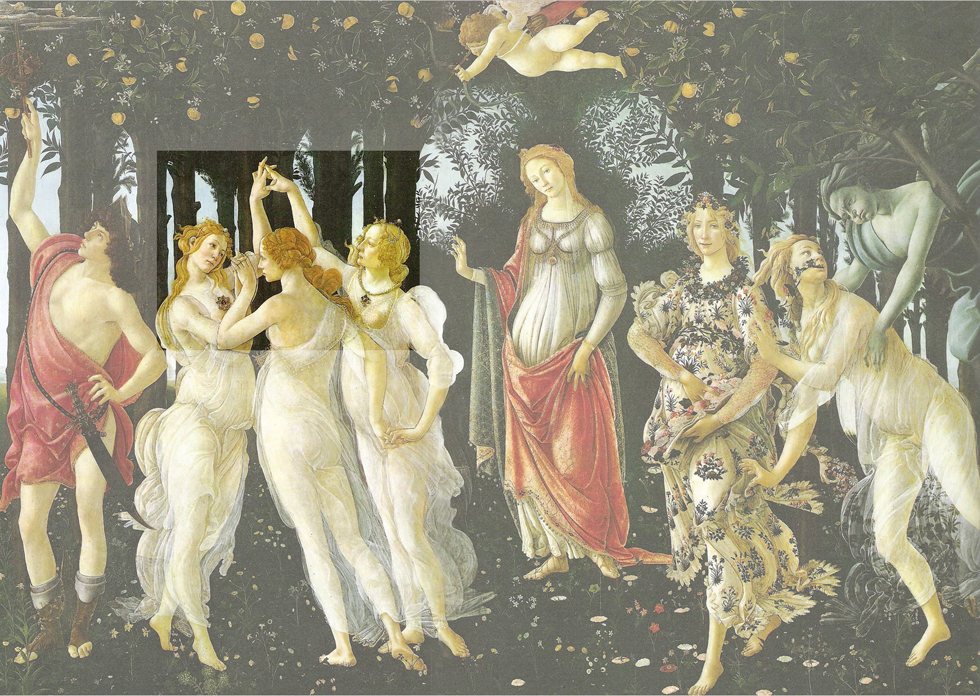
Trudi’s imagery for her Veritas print is derived from a section (highlighted) of Sandro Botticelli’s famous painting Primavera, c. 1482, at the Uffizi Museum in Florence.
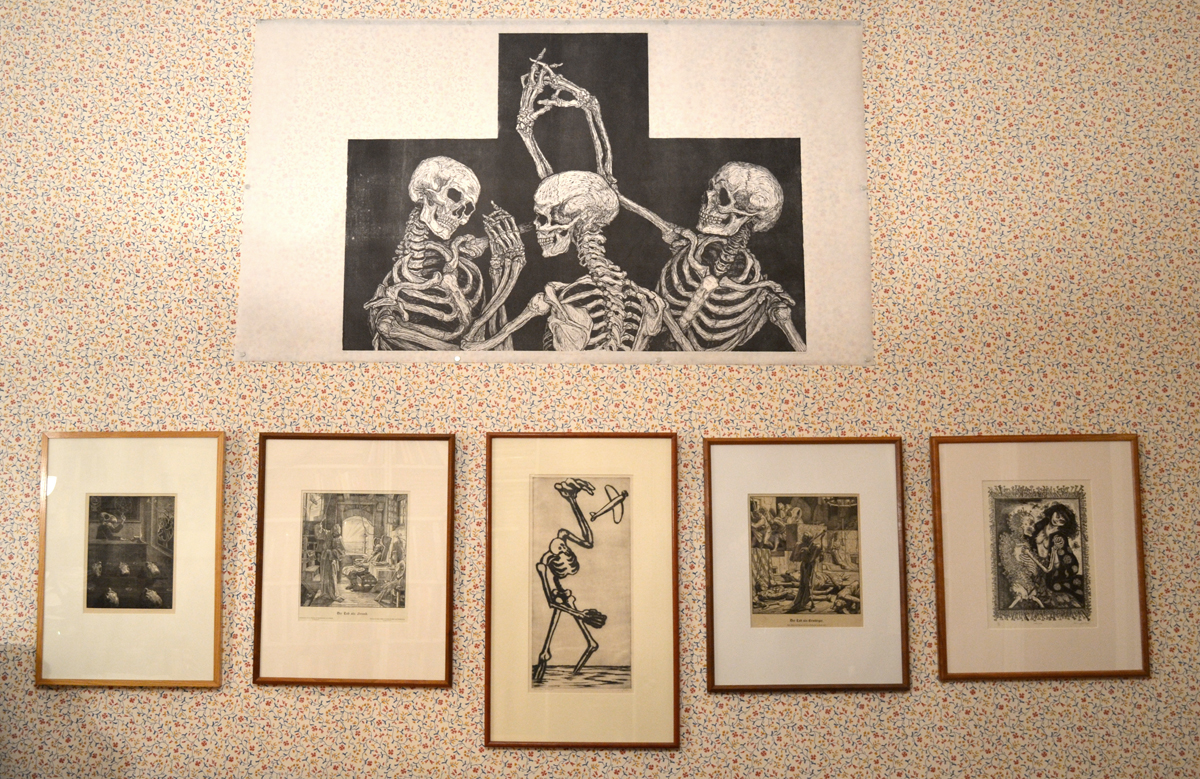
Below Trudi’s print in my office is: (L to R) Victor Delhez, Scherzo in Gold; Alfred Rethel, Der Tod als Freund; George Hagedorn, Perilous Flight; Alfred Rethel, Der Tod als Erwurger; and Rosemary Feit Covey, Nkonde.
Tell my what you have learned as far as carving anatomy while working on Veritas?
I learned more about how to do values and roundness. … I know where I started and I can tell where I finished just in terms of the cleanest of the marks and the more fluid the marks become, understanding that every mark you make has to be directional, so that you’re going the direction that the bone grows … even if you’re clearing out white spaces.
The print has two different dates on it. Can you tell me why that is?
When I first carved it, I met a deadline because you had gotten me to do it and my goal was to have it done for you at the end of the summer. Then I finished it, and I wanted it to be in the faculty show in 2000 at MICA. So I printed a couple, and one was framed, and then I didn’t have time or money to get more paper. It takes a real long time to get it all inked up and get it all barened up and made. [From Wikipedia: The baren is a disk-like device with a flat bottom and a knotted handle. Paper is placed on an inked block and the baren is used to burnish (firmly rub) the back of a sheet of paper to pick up ink from a wood or linoleum cut.]
Eventually in 2012, when I was doing an artist in residence at Wesley [Theological Seminary in Washington, DC], I encountered a person who really enjoyed my prints and had really good steady hands. It always takes another person to place the paper. It’s a two-person job. To ask somebody to give you a day of their time when you’re trying to place paper and be patient with you and help you baren stuff, so we set up a deal: She has one of every print of the whole edition that she helped me pull. We finished the edition for Carpe Diem, the one that’s based on Michelangelo’s Sistine [Chapel] ceiling fingers, and she helped me with Nosce te Ipsum, the Thinker one, and then we did all of these–finished off the edition since I declared an edition of 10. So we finished the edition recently. [Carpe Diem and Nosce te Ipsum are both skeletal woodcuts but on a much smaller scale than Prima Veritas.]
Were they initially printed differently, technically? You said you were using a baren. Were you using a press initially?
The idea was that they were supposed to go through a press. But once I got it inked up and ran it through the press, there turned out to have a big hollow spot between the layers of the plywood. One whole passage of the cheek into the eye wasn’t going to print at all. You couldn’t pack it or anything. So I had to do it by hand barening it. And now you can’t tell [where the hollow is]. But I also came to realize that by pulling it by hand it has a nicer breath to it because, if you pull it with a press, it’s very even and it looks like lino. And then why would I have done a woodcut? So having done it by hand, you can see the sense of the woodcut better. And it has more atmosphere to it. So it’s a better choice.
Tell me about the development, the sequence of the cutting of this.
So I started with the skeleton in the middle. I decided that, if I started with the middle instead of working left or right, it would make more sense. So I worked my way up, and I actually started with a different set of tools when I came to realize that I had to stop and sharpen them constantly. … I did the skull first, then I worked my way down the spine. But I had to keep sharpening the stupid tool. So I had to go looking for something better. I went out to a place–I can’t remember where it was; I don’t think it’s there anymore. It was a place where old guys who carve duck decoys would get their tools. The guy there said, “Come on back here,” and he starting showing me–“Look at this.” He had a whole bin of eyes. He said, “You gotta come down this aisle,” and all of these duck eyes and things would be looking at you. And he said, “You ought to try these,” and he gave me Flexcuts, and they are a dream.
Flexcuts?
Flexcut carving tools are ergonomic. They fit right into the palm. They have a wonderful spring to them. They are as sharp as death. They are so sharp that they come with a box of Bandaids. So that changed a whole lot about how I carved as well. I know the left skull and the middle skull and the whole spine system were done with the earlier, not-great tool. Everything else was done with the Flexcut.
Now that you say it, I can see it.
I don’t want you to know that.
No, no, no, we can talk shop. It’s OK.
But I learned a lot. Look how much more the skull on the right … I was finally at home there. Figuring out how much light to let in to the rib cages. I learned I didn’t need to tell you everything, just get the hint of the ribs in there. And figuring out how to do the inside of the spinal column, deciding how much light could be where. Yeh, you can see, if you really start looking at it, where I started learning. It was the fourth woodcut I’ve ever done, and of course I decided to go huge. That’s how that works.
You jumped in whole hog.
Yeh, you know ’cause I’m such a slouch.
How do you feel seeing it up?
I’m really delighted. It seems that it fits really well here. I’m actually thrilled that it’s not stuck in a frame. I like to see it have “breathability.” It’s not under plexiglass; it’s not under glass. So you can see just what it is, and that makes me very happy because you lose contact with it when it’s framed.
Every time I framed things up I have the same feeling that I lose it a little bit.
Yeh, and Prima Veritas has such a nice breath to it. I’m absolutely delighted and thrilled and pleased as punch that the flowers [of the wallpaper] show through because that of course enhances it. I mean–come on. It’s like that whole painting was a tapestry; so it looks like it comes full circle. It’s hilarious.
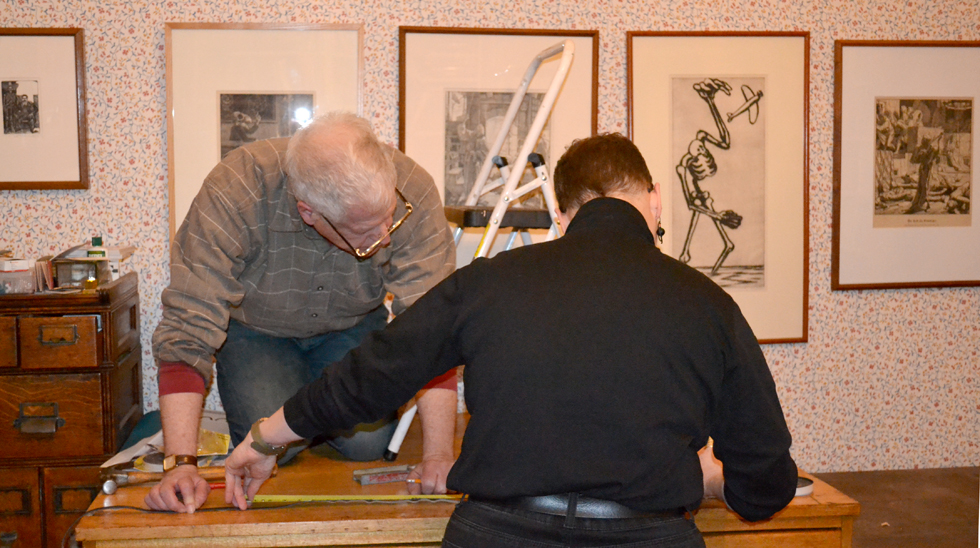
Two photos of Trudi and me working to hang Prima Veritas. (Above) We’re measuring the magnetic tape that will be hung where we want the top edge of the paper to be. (Below) We’re placing one-inch pieces of magnetic tape so we can adhere the bottom edge of the paper. Note that you can see under the top of the paper a dark stripe where the strip of magnetic tape was placed. (Photos by Michael Frommeyer)
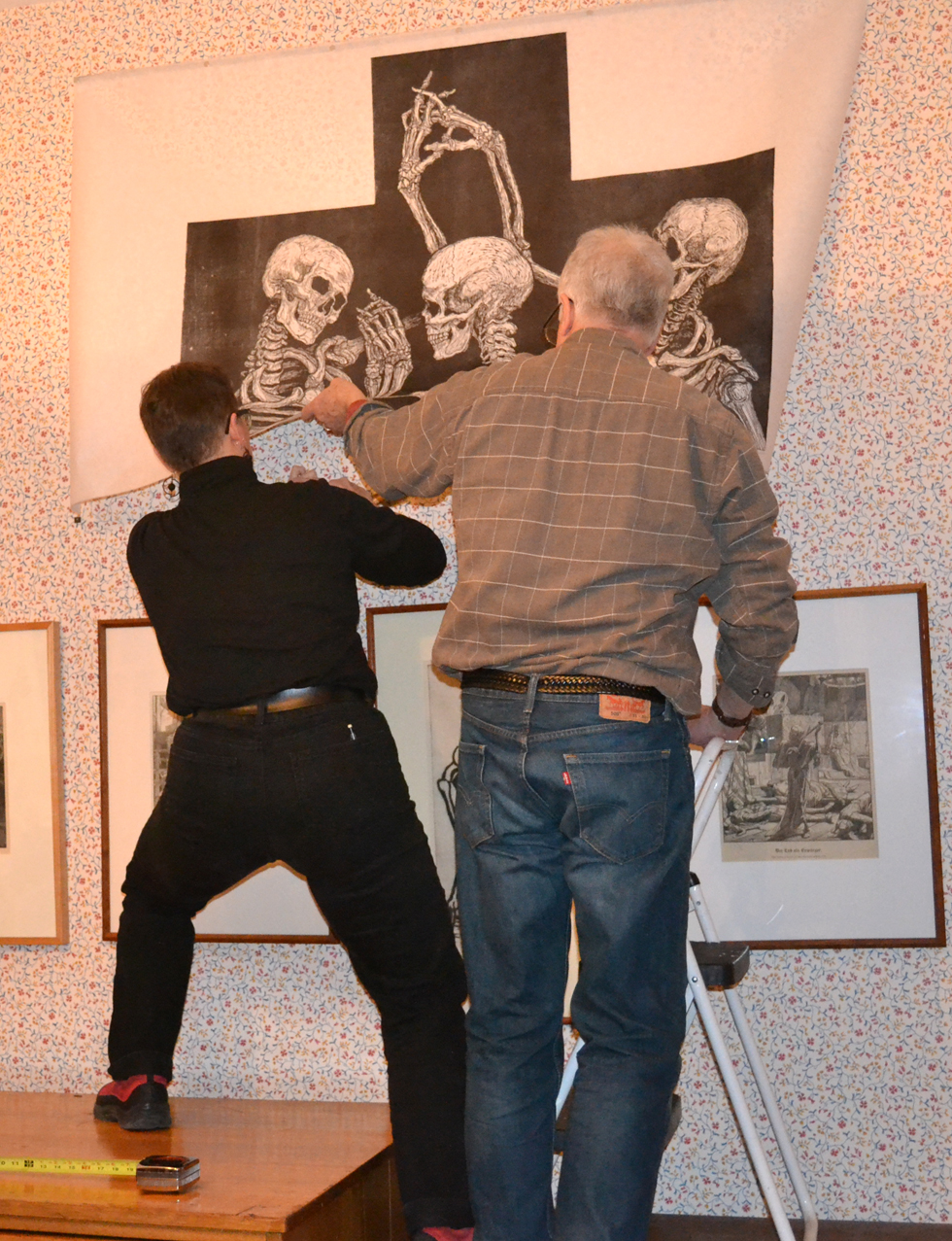
The Exposure of Luxury
Trudi’s second oversized skeletal woodcut was based on Agnolo Bronzino’s painting An Allegory with Venus and Cupid, c. 1545, at the National Gallery in London.
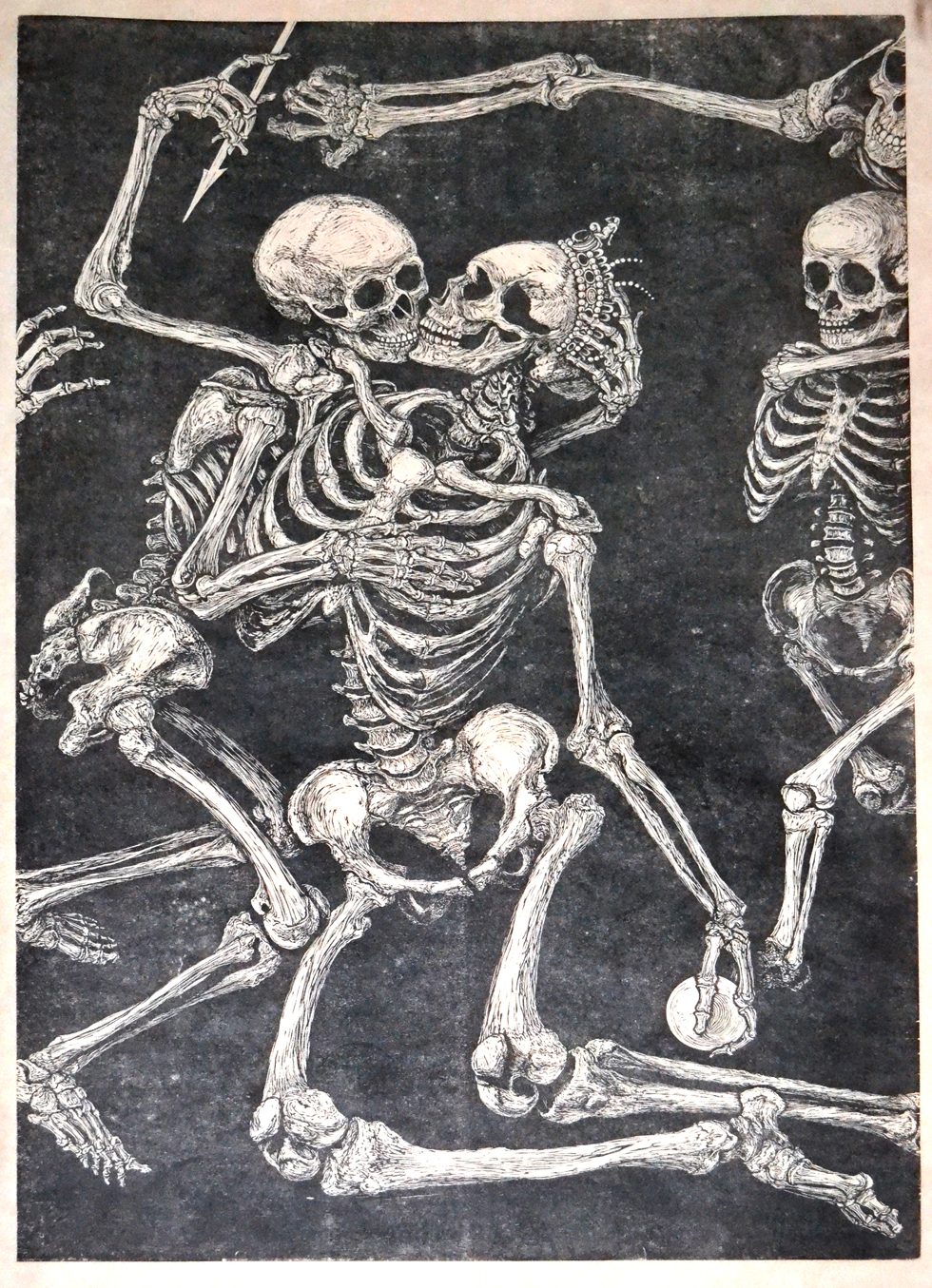
Trudi Ludwig Johnson, The Exposure of Luxury, woodcut, 2013, 3/11, 48″ x 31.5″ on Okawara paper. (Photo by Scott Ponemone)
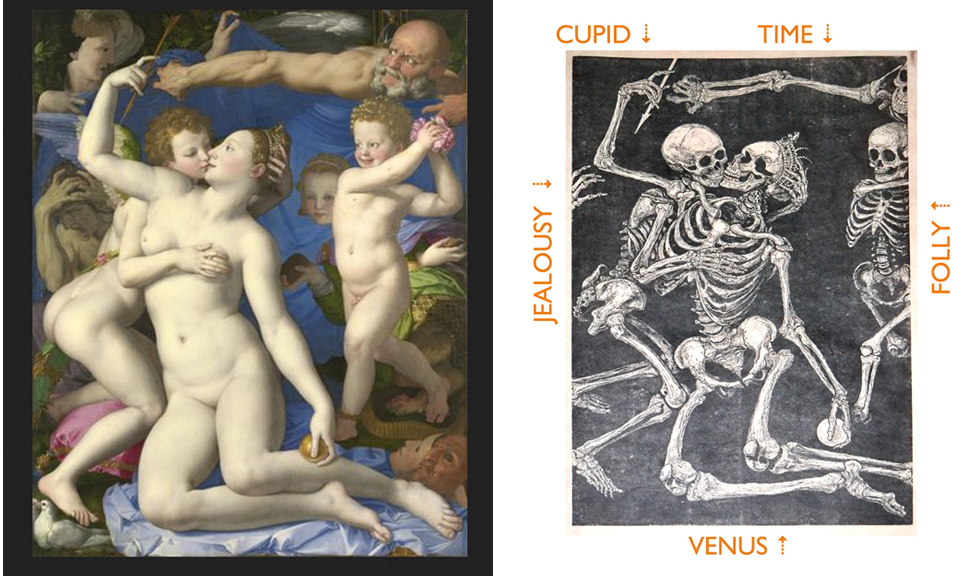
Bronzino’s An Allegory with Venus and Cupid juxtaposed with Trudi’s woodcut with labels naming the participants that she chose to include. Note how many figures she left out and how she cropped in especially on the right.
Can you see how much better you carved this block?
See the 53 pearls there [in the tiara]? Each of them had to be done very carefully. I had to make sure that there wasn’t anybody in the house, and it took me the entire weekend because circles are the worst thing you could carve across grain and everything. And the ways the eyes sink in better now. Yeh, there’s a whole lot that I learned differently. Even here in this ball: How do you make a ball in woodcut? I’m pretty happy with that. And there’s little passages where–even if you didn’t care what they were–there’s some wonderful little abstractions that happen there. You see how that melts in there?
Between those two bones there on the leg below the knee?
Yeh, I’m real happy with that. See how it melts away there? And how that one melts off? I was just in a really good place to do those. Sometimes I would get up at 3 in the morning, pad across the parking lot [at Wesley] and go carve because I had to. It was just the most delightful thing. If I could live there all the time and carving some, I would.
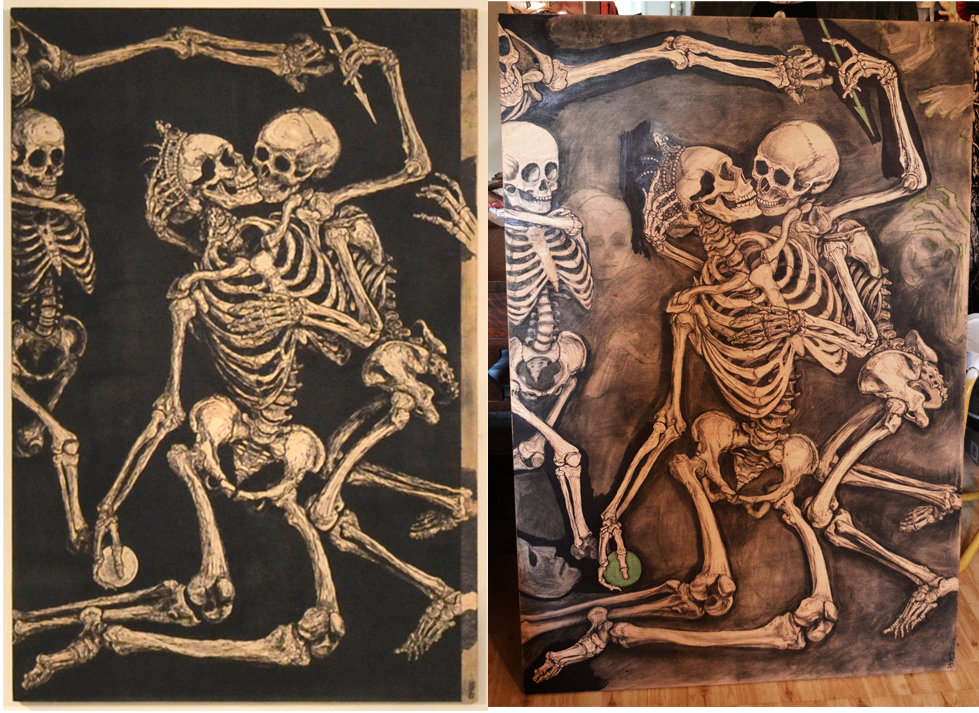
(Left) The woodblock for Luxury was shown at Trudi’s Washington Printmakers exhibition. Note that the right margin was not inked up nor completely carved. (Right) The block for Luxury was partially cut when I visited Trudi in her studio in the summer of 2012. (Photos by Scott Ponemone)
You didn’t go all the way to the margin of your drawing. You left out some.
I wanted to close in on them [the central figures]. At first, I think, I was just going to let it be them, but it was way too empty. So I let Folly start of sneak in there. And it was obvious that I had to have the weight of the arm of Time up there. And I’ll be honest with you: There had been an inch and a half on the left-hand side there, but I didn’t like the balance. So I taped it off, and the composition felt better, but it was too empty. So I had to add in that hand, which is actually the hand of Jealousy, which was really needed to be in for weight and balance. I’m really happy I added it in. It was the very last thing I added because the light percolating through it wouldn’t have worked as well.
What printing issue did this particular print have?
I was using different paper. This is Okawara.
And what was the other one?
Mulberry. Okawara is wonderful Japanese paper. I was under the impression that I was going to use the fuzzy side toward the block. That’s the way I had been taught. But it turned out that the smooth side [of the paper] to the block made all the difference. It picked up ink in a much better way, and just being even on a huge amount of space like this is really something. … There were still things about the wood that were annoying. There’s a moment in there that looks like, well, it’s in the wood. It’s how it went through the joiner. Then I realized–you know what–it’s wood. It’s a natural substance. It’s not like linoleum. It needs to have its strange little moments. I’m kind of delighted it has this peppery-ness to it because then it could be soil, it could be space. So the print gets to be what it wants to be as opposed to what I thought I was going to tell it to be. And it’s important.
What do you think about it being hung as a banner?
I’m thrilled, absolutely thrilled. And it fills the space right, and it gets all this room. Again I’m so pleased it’s not smothered in a frame. I have one that I framed. I gave it to the Seminary as my thank-you. It looks OK, but there’s plexiglass on it, and it’s going to stick to the plexy and it doesn’t get to be itself. This one just breathes, and I’m really thrilled. I’m pleased.
I’m very pleased too.
It only took 14 years [for both prints].
Only 14 years?
Yeh, but I pulled three of these [Luxury] in 2012 and finished the edition this year. So it only took 3 years to get done.
Like nothing.
Yeh, why not get it done in just 3 years. But I actually have a full edition of all of them now.
So what’s next?
I said to myself I was kind of done with the skeletal stuff. But I still want to do [Andrea] Mantegna’s Dead Christ because it’s just the one to join the set. And then I should give it a little rest because I want to get on to Genesis as opposed to skeletons.
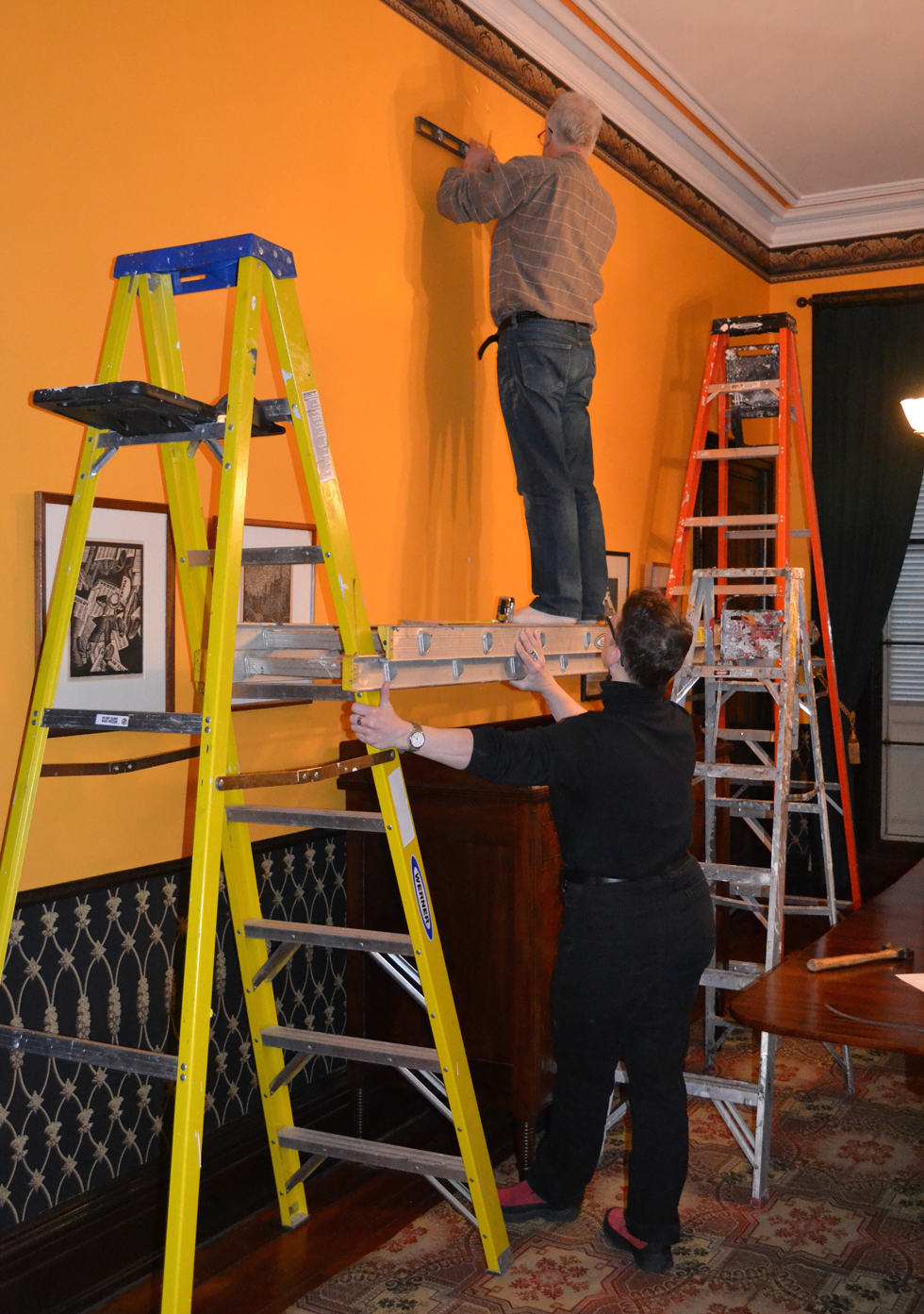
Hanging Luxury required us to rig up scaffolding because the dining room sideboard was too heavy to move and too delicate to walk on. (Top) I’m using a level so I could position the magnetic strip that would run underneath the top edge of the paper. (Below right) I’m adding the first few neodymium magnet discs across the top before unfurling the print. (Bottom left) I’m adjusting the spacing of the discs. (Photos by Michael Frommeyer)
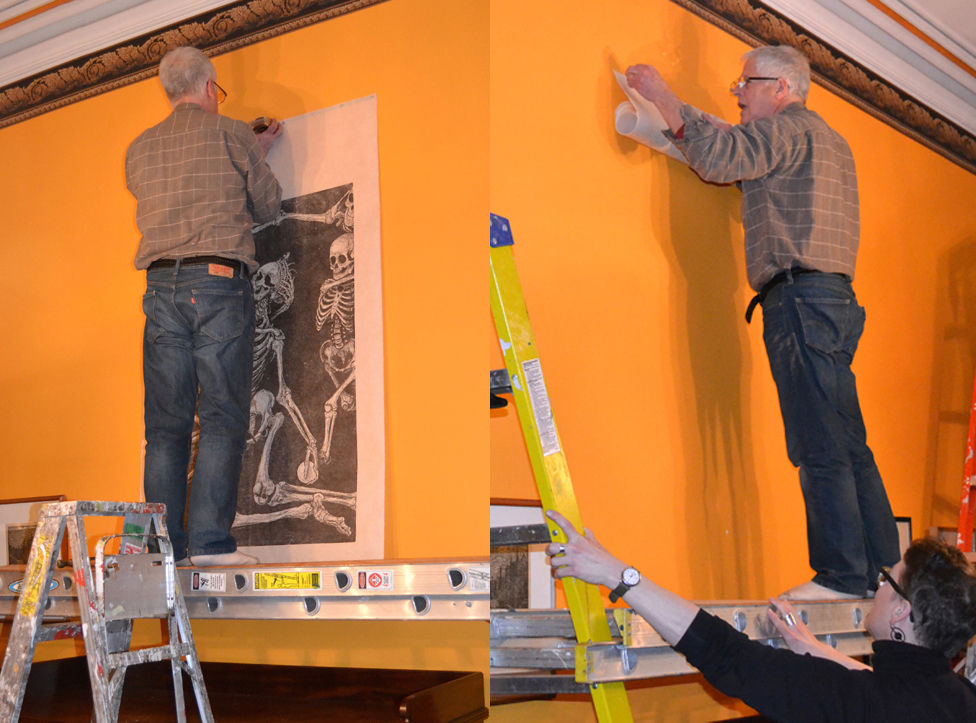
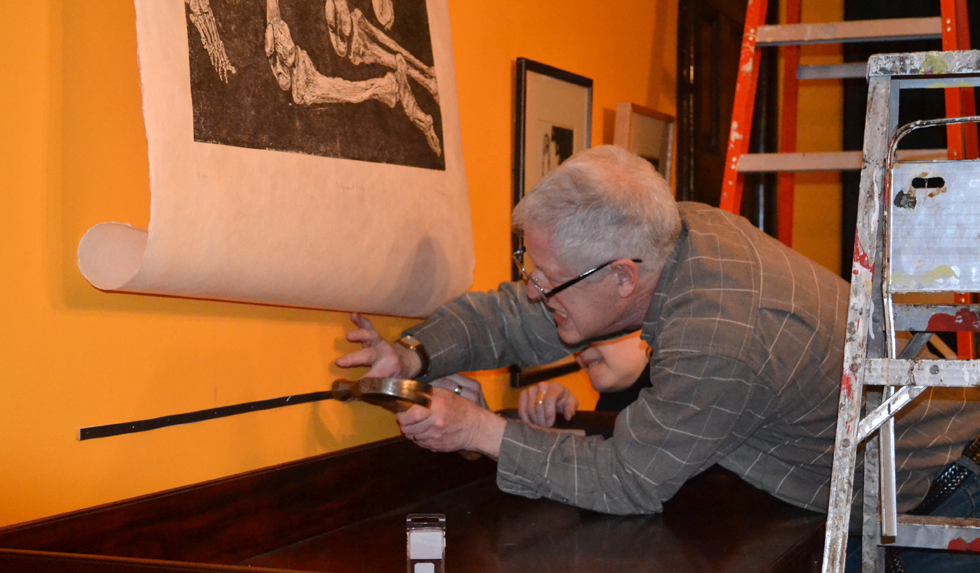
(Top) I’m nailing down the magnetic tape that will hold down the bottom edge of the print. (Bottom) The competed installation of Luxury. (Top photo by Michael Frommeyer. Bottom photo by Scott Ponemone)
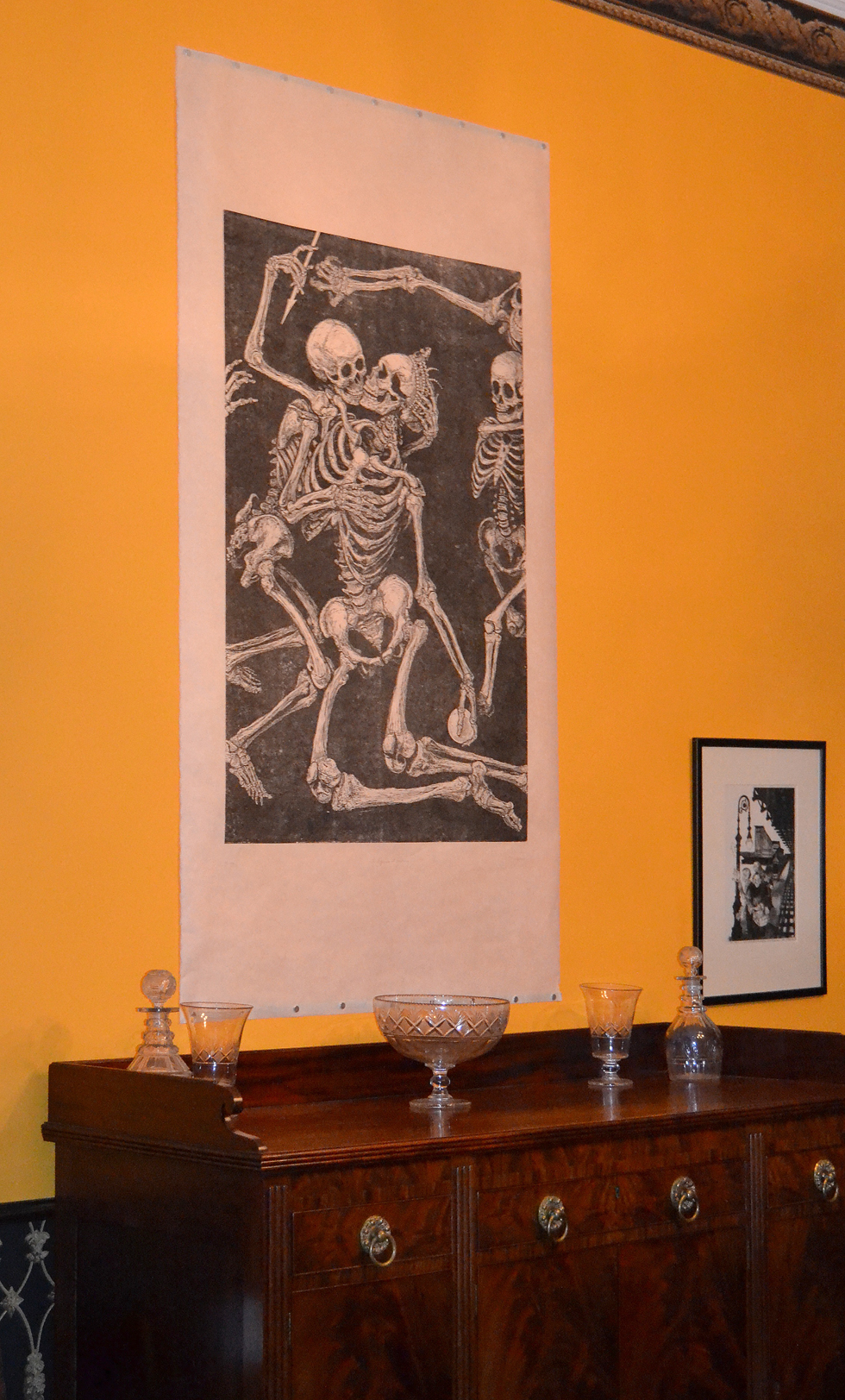
ADDENDUM
Trudi signed both prints simply “Ludwig.” After reading this post, she remarked, “I actually sign all of my artwork ‘Ludwig’ and (only grudgingly) use ‘Johnson’ at work. I had always been listed as Trudi Y. Ludwig at WPG [Washington Printmakers Gallery].”
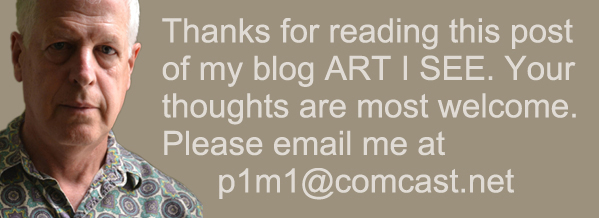
Trackback URL: https://www.scottponemone.com/trudi-ludwig-johnson-mission-accomplished/trackback/












Thanks for writing this! I just discovered Trudi’s work because she is a friend of a friend. I never even thought about the woodcutting process beyond what it took to do a linoleum block cut in junior high. What a treat to get a bit of insight into the process and be introduced to a talented artist with a fascinating style and subjects at the same time. And I really felt as if I were there with the both of you and the prints.
I’m going to share this on Facebook now….
Lorel
I’m sure Trudi would love to read this. May I pass it along?
Scott